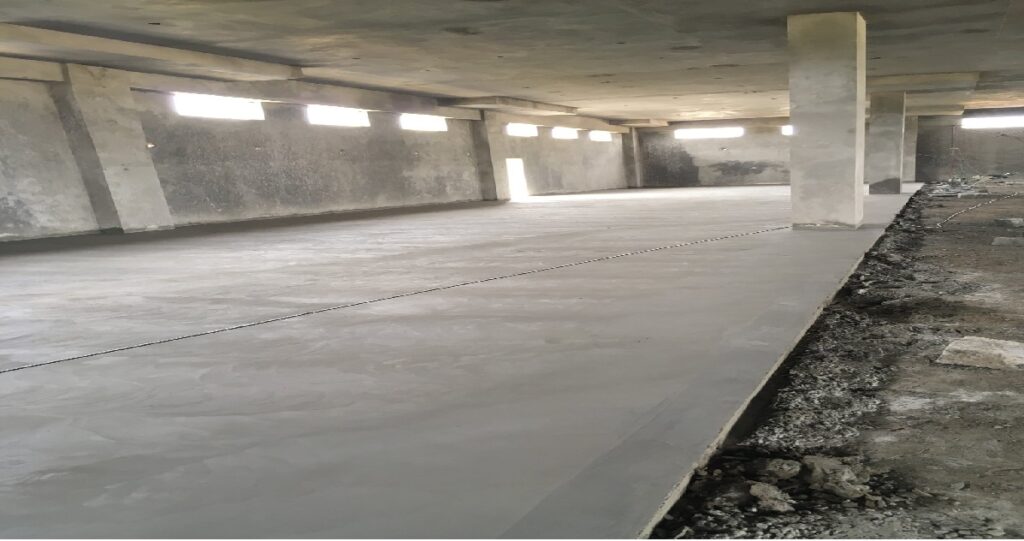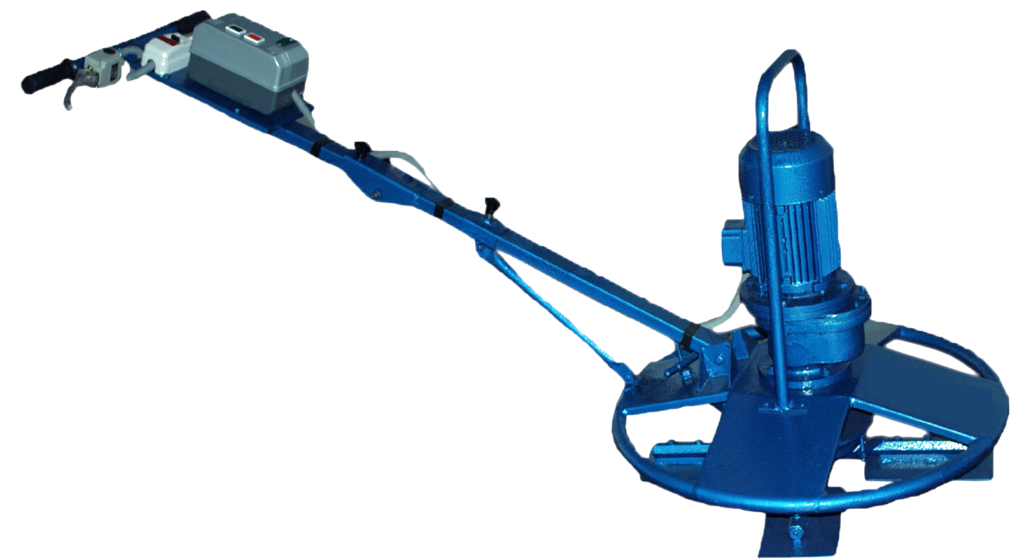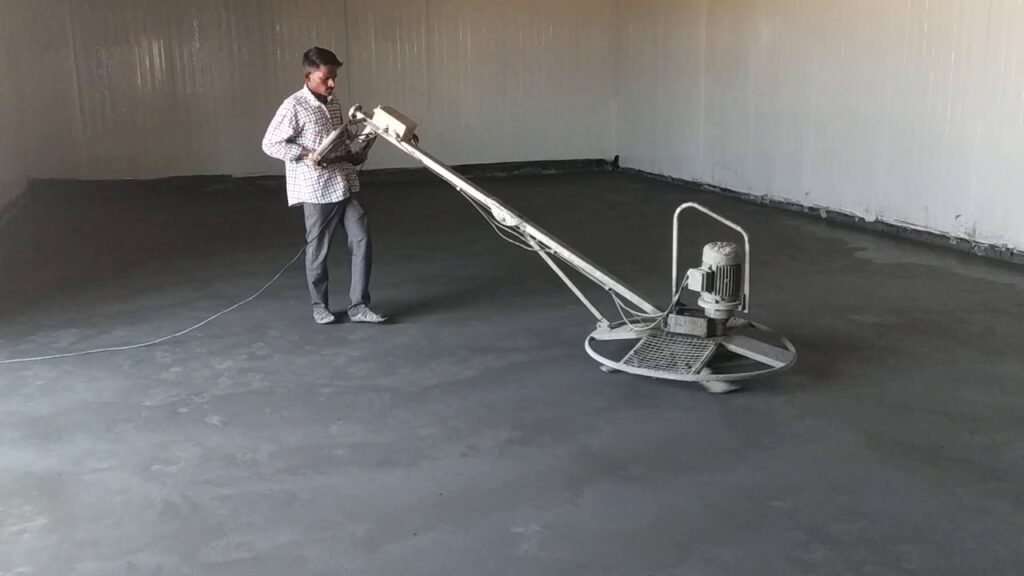What Everybody Ought To Know About Trimix Flooring?
Table of Contents
What Is Trimix Flooring?

Trimix flooring is a special type of flooring, generally used for industrial purposes. It has a better wear and tear property. It is mostly done in the industrial sector, where rigid surface is necessary for machine foundation, light load cranes and light weight carrier vehicles. Generally, the concrete mix used for trimix is 1:1:5:3 (1 cement: 1.5 sand and: 3 stone aggregates), mostly rich mix of 1:1:2 is preferred for better wear and tear.
In this flooring necessary reinforcement depends upon the thickness of the flooring, whereas the thickness of concrete is decided from 100 to 200 mm over PCC (1:4:8) and well-prepared stone soling base ranging from 230 to 300 mm. In industrial flooring PCC base should be kept up to 100 mm and same as concrete 150 mm, may be satisfactory for heavy duty areas such as warehouses, garage, and machine shop.
Trimix Flooring Machine

| Model Number/Name | TRIMIX01 |
| Automation Grade | Semi-Automatic |
| Material | MS and Casting |
| Blade Diameter | 1000 mm |
| Number of Blades | 4 |
| Speed | 60 to 120 RPM |
| Power | 3 HP 3 Phase |
| Blade Thickness | 2 mm |
Trimix Flooring Machine consists of a Double Beam Screed Vibrator, a Trowel cum Floater, Vacuum Pump and Groove Cutting Machine. There are certain advantages of using dewatering systems over normal concrete slabs. It increases the tensile strength of the floor. It reduces the water cement ratio compared to the normal concrete slabs. There is a faster initial strength gain in cases where dewatering systems are used. There is also a rise in abrasion resistance when vacuum dewatering systems are used.
Double Beam Screed Vibrator:
Double Beam Screed Vibrators are used to give a uniform RCC flooring. The heavy weight removes any external air bubbles of the RCC flooring. The difference in superior compaction is seen by the heavy weight it eludes.
Vacuum Pump 7.5 HP and 5 HP:
Vacuum Pump is used to suck all the air bubbles that are trapped during the laying of the concrete. It allows the cement to come up to upper layers and hence gives superior strength to the floor. The three mats: filter mat, suction mat and top mat, these mates do not allow cement to come up but only sucks the extra water.
Floater Cum Trowel:
Floater cum trowel is powered by 3 HP geared motor and is used to give a superior finishing to the RCC flooring. The gear box is heavy duty and sturdily designed for rough Indian conditions. The dish used for finishing is 4 mm thick and is very important to maintain a long life. This machine also works as a trowel for the best finished floor. Converting from floater to trowel is very easy.
Trimix Flooring Specification
Materials And Tools Required:
All mason tools and tackles are required to be available on site. However, some special tools required are as follows:
- Groove cutter
- Trowel cum floater
- Vacuum dewatered pump
- Double beam screed vibrator
Material shall be as per specification such as Mix 1:1:2 and floor hardener.
Flooring Procedures:
- Prepare the sub-base by watering and ramming properly. Ensure no loose materials are left. Level the surface and lay 230 mm to 300 mm stone soling/boulder soling layer of 150 mm compacted properly.
- Floor slope should be maintained in PCC work, which shall be laid above the stone soling. The thickness of PCC shall be kept to be 100 mm.
- Trimix must be done in panel and each panel shall be of 3.5 meter and appropriate reinforcement bar shall be laid in layer of one or two, keeping the concrete cover of 50 mm (it may differ as per standard).
- Vacuum dewatering machines are useful to remove excess water from the top layer of wet concrete without removing the cement of sand particles.
- This is done soon after concerting, ramming, or vibrating with screed vibrator, and levelling first round troweling, when the concrete is fresh. It will not only increase the strength of the concrete but also increase abrasion resistance of the floor.
- Also, it is always good if a hardener is to be used to increase abrasion resistance of floor while using floater machine at the time of finishing the floor surface. Shrinkage cracks are also minimized by using this system.
- To avoid shrinkage cracks and increase the abrasion, polyurethane fibers and floor hardener are to be added to concrete in small amounts. The quantity of fibers and hardener is prescribed by the manufacturers.
- Casting concrete flooring in panels avoids shrinkage cracks and works as expansion joints, it is slow and time-consuming process, especially when large area is to be floored.
- The concrete lay in panels without construction joint then after panel joints should be cut with help of cutting saw after 7 to 10 when concrete is not fully hardened. The gap so created is filled with sealants or polysulfide.
Trimix Flooring Process
- Objective– This work procedure narrates the guidelines to be adopted for trimix or vacuum dewatered concrete flooring (average 75 mm thick) for podium and basement.
- Applicability– This procedure is applicable to all trimix flooring works.
- Reference Document– BOQ, Standard Specifications, Drawings.
- Responsibility– The Project Manager is responsible for the overall implementation of the procedure.
- Safety Precautions– Only authorized people should handle the activities. Use PPEs like goggles, hand gloves, helmet, and gumboots.
- Materials, Equipment’s, and Tools used– M-25 grade concrete, steel tape, alignment thread, water-level or level instrument, M.S. sidetrack rails 50 mm thickness, leveling beam, wire brush, concrete float, surface vibrator, mechanical trowel, vacuum mats, and vacuum pump.
- Procedure–
- Surface where concrete is to be laid should be hacked, thoroughly cleaned, made free from dust, grease, loose material and wetted to have just moist surface. Roughly 80 to 100 sq m area shall be covered during one extension.
- Two sidetrack rails on which leveling beam and surface vibrator will be mounted shall be fixed approximately 4 m apart to desired levels. M.S. rails shall also be fixed at start and end where required.
- Placing of M-25 grade of concrete shall then be done manually spreading it in horizontal layers. On completion of 5 to 6 sq m area, surface vibrator shall be run over the surface to get required compaction.
- This process is continued and surface vibrator be run second time along with leveling beam to finish of concrete at desired level. Vacuum mats 4 m x 4 m shall be placed on this leveled concrete to squeeze out and remove excess water from the concrete using vacuum pump.
- A time of 1.5 to 2.0 minutes per cm thick concrete slab is normally required for this operation. (i.e., 15 min). Thereafter floating operation should be started with power operated skin floaters and floating shall be continued till desired finish is obtained.
- After the surface hardens, curing shall be started by ponding and shall be continued for minimum 7 days. Joints in concrete are cut at construction joints and are made by sawing the already laid and finally cured concrete to obtain 40 mm depth and 4 mm width groove.
- These joints shall be cleaned and filled with bitumen grade (80-20) mixed with dry sand. Expansion joint shall be placed as per drawings and shall be formed by placing the 25 mm thick compressible material board. Joint at top 15 mm shall be filled with bitumen grade (80-20) mixed with dry river sand.
Trimix Flooring Labour Rate

Our labour rate for trimix flooring is priced at Rs 65-75 / sq ft but is susceptible to changes.
Frequently Asked Questions about Trimix Flooring
What Is Trimix Construction Or What Is Trimix Concrete Flooring?
Trimix concrete flooring is a type of special flooring mostly done in the industrial sector. It provides better wearing and tearing properties. It is generally used for industrial purposes, where a rigid surface is necessary for machine foundation, light load carrier vehicle and light weight cranes. In the trimix flooring, necessary reinforcement depends upon the thickness of the flooring.
How Is Trimix Flooring Done?
The floor finishing is done with vacuum dewatered process and the top layer is finished with mechanical trowel. This is used in heavy material factories to minimize the damage to the floor.
Basic Provision For Trimix Flooring:
Normally the concrete mix used for Trimix is 1:1.5:3 (1 cement, 1.5 sand, and 3 coarse aggregates). The thickness of Trimix Flooring varies from 100 mm to 200 mm. In industrial flooring, the PCC base should be kept up to 100 mm and Trimix Floor at 150 mm.
Material And Tool Required For Trimix:
– Double beam screed vibrator
– Vacuum dewatering pump
– Floater cum trowel
– Groove cutter
Procedure For Trimix Flooring:
1. Prepare the sub-base by watering and ramming, make sure there is no loose material left. Level the surface and lay 230 mm to 300 mm stone soling and it should be compacted properly.
2. Floor slope must be maintained in PCC work, which must be laid above the stone soling. The thickness of the PCC shall be kept to 100 mm.
3. A trimix must be done on the panel and each panel must be 3.5 meters and an appropriate steel bar must be laid in layer one or two keeping the concrete cover of 50 mm.
4. Vacuum dewatering machine removes excess water from the top layer of wet concrete without removing the cement of sand particles. This is done soon after concreting, ramming, and vibrating for fresh concrete.
5. It is not only increasing for the strength of concrete but also for the abrasion resistance of the floor. Shrinkage cracks can be minimized by using this method.
6. Casting of concrete flooring in panels avoids shrinkage cracks and works as expansion joints. It is a time-consuming process when a large area is to be covered.
What is The Difference Between Trimix And PCC?
Trimix must be done in the panel and each panel shall be 3.5 meters and an appropriate steel bar shall be laid in layer one or two keeping the concrete cover of 50 mm.
While floor slope must be maintained in PCC work, which shall be laid above the stone soling. The thickness of the PCC shall be kept to 100 mm.
Trimix Flooring Section Detail
 Cross Section of Concrete Road
Cross Section of Concrete Road